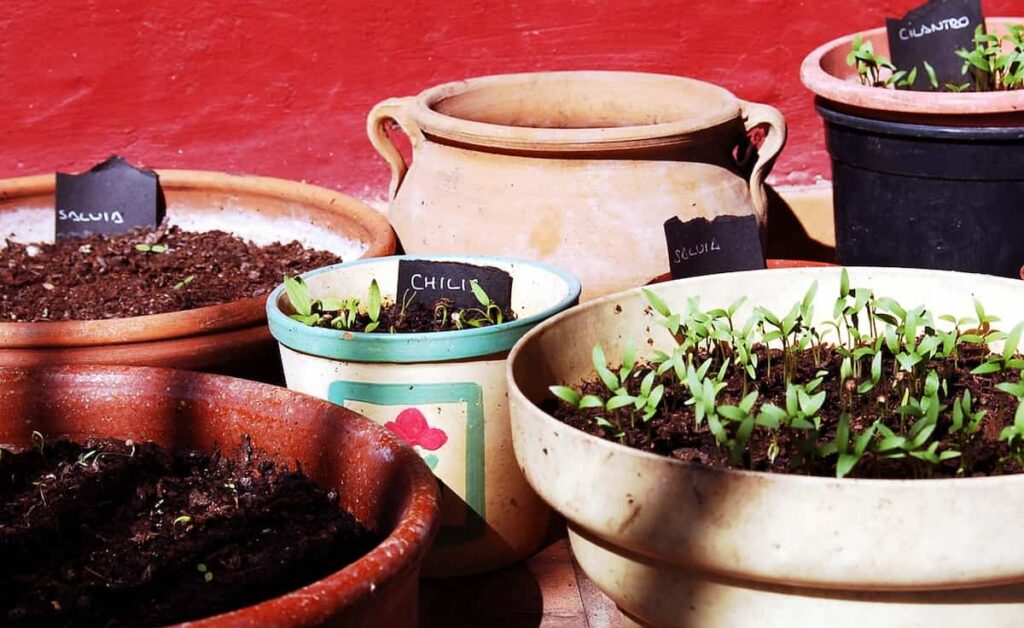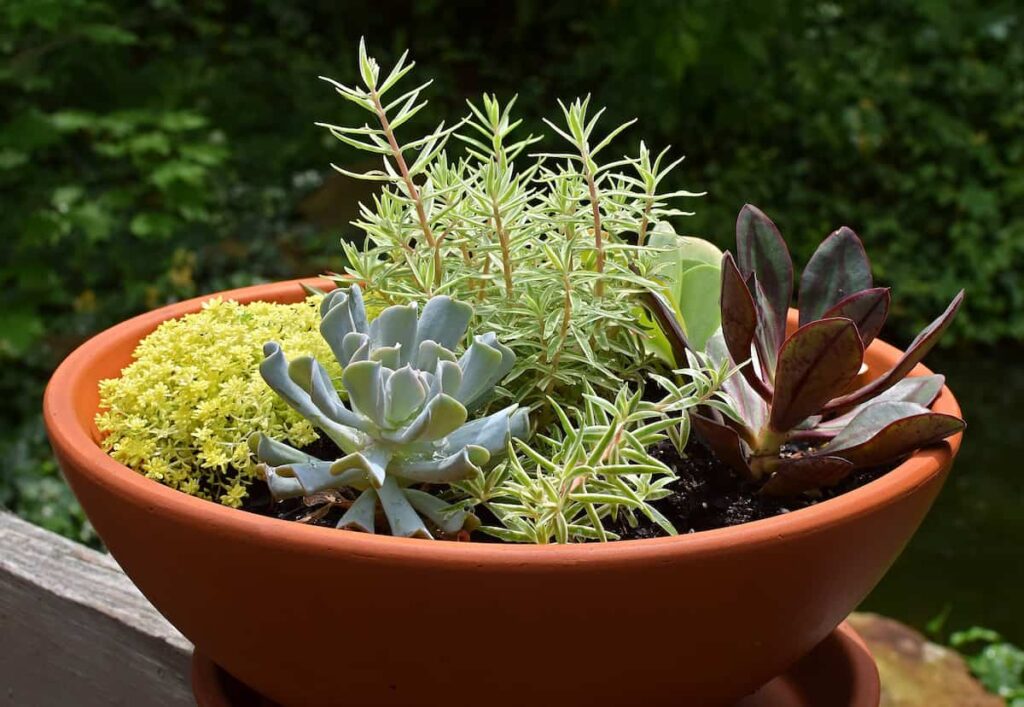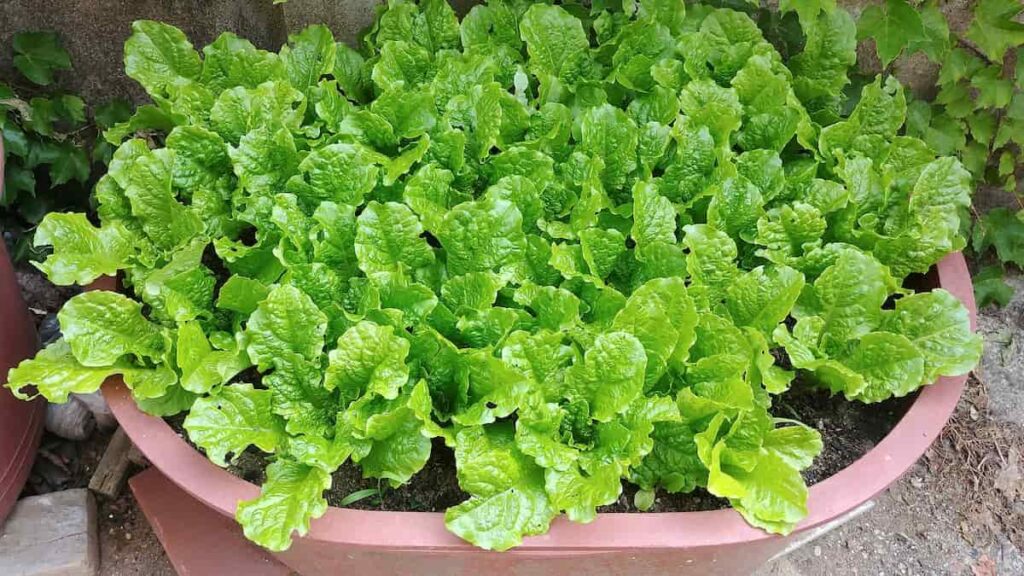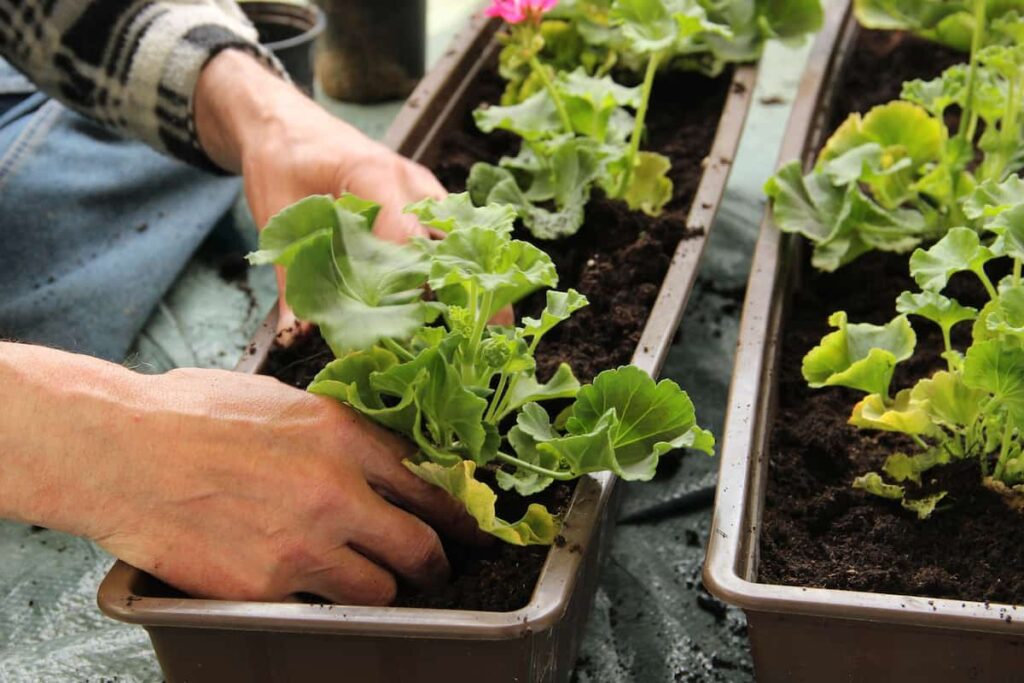If you’re new to gardening, container gardening is a great way to start. Container gardening is the best way to grow fruits, vegetables, and herbs without investing in equipment or space. There are a few key rules to follow to be successful when it comes to container gardening. When planning your garden layout, it is essential to consider the amount of sun and shade each plant will need.

You should consider the size of the containers you will be using. Using the right size container for each plant is essential, as this will impact the plant’s growth and yield. With some planning and effort, you can enjoy all the benefits of fresh fruits and vegetables. From planning your garden layout and choosing the proper containers to reduce production costs. By planning and being flexible with your choices, you can easily save a significant amount of money on your container garden.
42 Key Rules for container gardening
Key rules for choosing the right container for container gardening
- Success with container gardening depends on choosing the correct container. If you’re looking to reduce production costs, opting for cheaper materials like plastic or terracotta can help.
- You should choose a container with drainage holes at the bottom. Plants need access to water, but they also need proper drainage to avoid root rot. Check the bottom of the pot for drainage holes and ensure they are not blocked.
- Consider the size of the plant when selecting a pot. Ensure the pot is large enough to accommodate the plant’s roots but not so large that it becomes unwieldy.
- Round pots are a classic choice for container gardening. They’re perfect for small spaces and can be placed close together without taking up too much room. Plus, they’re easy to move around if you need to rearrange your garden.
- Square pots are another popular option for container gardens. They offer more space than round pots, so they’re best for larger plants or gardens with multiple plants.
- Rectangular pots offer more space than round pots but aren’t as bulky as square pots. They can be placed side by side or in rows to create a neat garden layout.
- Oval pots are similar to rectangular pots but have rounded edges. This gives them a softer look that’s perfect for cottage-style gardens. They also offer more space than round pots while still being easy to move around.
- Select a material that will allow your plant to breathe. Look for terracotta or glazed ceramic materials that allow your plant to breathe.
- Terracotta pots are classic choices for container gardens. They’re attractive and durable, but they can be heavy and tricky to move around once they’re full of soil and plants.
- Plastic pots are lightweight and inexpensive, making them a good option for large or heavy plants. They’re not as attractive as other materials, but they’re easy to clean and won’t break if dropped.
- Metal pots are another popular choice for container gardens. They come in various styles and sizes and can be decorative or functional. Like plastic pots, they’re easy to clean but can be dented or scratched easily.
- Wooden containers are usually made from cedar or other rot-resistant wood. They give your garden a natural look but must be regularly treated with a weatherproofing sealant to prevent them from deteriorating.
- Choose a color that complements your plants. While this may seem minor, it can greatly impact your plants’ appearance in their pots. Select colors that blend in with your plants or provide a nice contrast.
In case you missed it: Balcony Grill Garden Ideas: Small Spaces, Apartments, and Best Plants to Grow on Grills

Key rules for choosing the right plants for the container gardening
- Regarding container gardening, one key rule is picking the right plants. Not all plants are suitable for growing in containers, and you need to make sure that you pick ones that will thrive in the limited space and soil that a container offers.
- Regarding plants, using cheaper and more readily available annuals can also help reduce costs. Plus, since they’ll need to be replaced more often than perennials, you’ll have an opportunity to experiment with different plant combinations each season.
- When picking plants for a container garden, you must consider whether they are drought-tolerant. This is specifically important if you live in an area with hot summers, as your plants will need to survive long periods without water. Many beautiful drought-tolerant plants are available, so you should have no trouble finding ones that suit your taste.
- Another thing to consider when choosing plants for your container garden is their root structure. Some plants have aggressive roots that can quickly fill a small pot and choke other plants. Choose varieties with more compact root systems if you want to grow many plants in one pot.
- Finally, pick plant varieties that suit the amount of sunlight your garden gets. Container gardens can be placed in full sun, partial sun, or full shade, depending on your preferences and the needs of the plants you have chosen. Read the planting instructions on each plant before making your final selection.
Key rules for choosing the right soil mix for the container gardening
- If you’re going to be successful with container gardening, getting the right soil mix is essential. The type of soil you use will depend on the plants you’re growing and the size of your containers. The type of soil you use can make a big difference in how well your plants grow and how healthy they are.
- For most plants, a good-quality potting mix will do the trick. You can find the potting mix at your local garden center or nursery. If you’re growing plants that require a lot of drainages, such as succulents, cacti, or herbs, you may need to add some extra perlite or vermiculite to the potting mix.
- There are two main types of soil: potting mix and garden soil. Potting mix is a lightweight, sterile mix that is designed for containers. It is made up of peat moss, vermiculite, perlite, and sometimes sand or compost. Garden soil is heavier and denser than potting mix and can compact easily in containers. It is also full of nutrients that plants need to thrive.
- A potting mix is a good option for growing vegetables or herbs. Garden soil is a better choice for growing flowers or other ornamental plants.
- Whichever type of soil you choose, add some organic matter to it before planting. This will help improve drainage and aeration and give them the nutrients required to grow strong and healthy.
In case you missed it: Soil pH Levels for Vegetables, Fruits, Flowers, and Herbs: How to Lower and Increase Soil pH, Chart and Optimum Range

Key rules for choosing the best location for the container gardening
- For a successful container garden, it is essential to place your containers correctly. Make sure your containers get enough sunlight. Most plants need at least 6 hours of sunlight per day, so choose a spot with plenty of sunlight. You can put your containers on a windowsill or porch where they’ll get plenty of light. If you have little space.
- Avoid placing your containers in windy areas. This can dry out the soil and damage your plants. Consider the drainage of your containers. If water doesn’t drain out, it can lead to root rot, killing your plants.
- Keep an eye on the temperature. Some plants like cooler temperatures, while others prefer warmer climates. Make sure to research what temperature range is best for the plants you’re growing before choosing a spot for your containers.
Key rules for watering container garden
- Watering your container garden is the most important aspect of keeping your plants healthy and happy. Water deeply and regularly. Container gardens need to be watered more frequently than in-ground gardens because the roots are confined to a small space, and the soil dries out more quickly. Water your container garden deeply and regularly, ensuring to wet all the soil.
- Don’ton’t water your plants if the soil is already moist. This can lead to root rot. You should check the soil’s moisture level before watering. Ensure your containers have good drainage so excess water can escape and roots don’t sit in soggy soil.
- Add drainage holes to containers if they don’t already have them, and consider using a planting medium that promotes good drainage, such as perlite or vermiculite.
- The best time to water container plants is in the morning. You should not water in the evening, as this can leave plant leaves wet overnight, leading to fungal diseases.
In case you missed it: Summer Watering Guide: For Vegetables, Flowers, and Herbs

Key rules for planting a container garden
- To have a successful container garden, you must first understand how to plant seeds and seedlings properly. When planting seeds, use a quality potting mix that is well-drained. You can add some organic matter to the mix, such as compost or manure, to help improve drainage and aeration. Seeds should be planted at the correct depth. Usually about twice as deep as the seed is wide.
- Once the seeds have been planted, water them well and keep the soil moist but not wet. Most seeds will germinate within 10 to 14 days if kept at a consistent temperature. Once the seedlings emerge, thin them out so that only the strongest plants remain. These should be spaced about 8 inches apart. To keep your plants healthy, water them regularly and fertilize them every few weeks with a balanced fertilizer. Monitor the soil’s moisture level; too much or too little water can stress plants and cause problems.
Key rules for fertilizing the container garden
- Regarding container gardening, one of the key rules is to fertilize your plants regularly. This will help them grow healthy and strong and reduce production costs. Keep a few things in mind when fertilizing your container garden.
- First, you need to make sure you use the right fertilizer for the type of plants you are growing. Second, you must apply the fertilizer correctly so your plants can absorb it properly. And finally, you need to be aware of how often to fertilize your plants so that you don’t overdo it and end up damaging them.
- For your container garden to be as productive as possible, it’s essential to use the right type and amount of fertilizer. Which type of fertilizer you use will depend on the plants you’re growing and the time of year. For most plants, a general-purpose fertilizer will suffice. If you’re using organic fertilizers, ensure they’re well-composted before using them on your plants.
- You can also regularly add organic matter to your container garden to help improve the soil quality. As a general rule of thumb, apply fertilizer to your plants every two weeks during the growing season.
- If your plants are starting to look yellow or sickly, you may need to increase the frequency with which you fertilize them. During the winter months, you can cut back on fertilizer applications.
In case you missed it: Homemade Fertilizers for Root Vegetables: Potatoes, Carrots, Beetroot, Onions, Radishes, Turnip, Ginger, and Garlic

Tips for protecting container garden from pests and diseases
- Pests and diseases are common occurrences in container gardens. You should start with healthy plants to prevent pests and diseases. Make sure to purchase plants from a reputable source grown in healthy conditions. Inspect the plants before purchasing them and avoid those that appear sick or have pests.
- Once you have your plants, you should keep them healthy by providing proper care. Water them regularly and fertilize them according to the instructions on the package. Be sure to remove any dead leaves or debris from the containers so that pests and diseases don’t have a place to hide.
- If you notice pests or diseases in your garden, act quickly to treat the problem. There are many organic and chemical treatments available.
Key rules for repotting container-grown plants
- Regarding container gardening, one key rule is ensuring that your plants are correctly potted. This means repotting them often to ensure they have enough room to grow.
- You should choose the correct size pot for your plant. The pot should be big enough for the roots to spread out but not too big that the plant becomes top-heavy.
- Use fresh potting mix when repotting. This will give your plant the nutrients it needs to continue growing.
- When repotting, you should not damage the roots. Gently loosen the roots and place them in the new pot before backfilling with potting mix.
In case you missed it: How to Grow Hostas in Your Backyard: Soil, Propagation, Planting, and Care

Tips to save dying container-grown plants
- If your plant’s leaves are wilting, it’s a sign that it is not getting enough water. Check the soil to see if it’s dry; if it is, water the plant deeply.
- If the leaves are discolored or have brown spots, it could be a sign of disease or pests. Inspect the plant carefully and treat it accordingly.
- If the stems are soft or mushy, it’s a sign that the plant gets too much water. Before watering again, you should allow the soil to dry out completely.
- Water the plant thoroughly and soak the root ball evenly. From its container, gently remove the plant and loosen any tightly compacted roots. Replant the plant in a fresh potting mix using a larger container than the root ball. Water the newly transplanted plant regularly, taking care not to overwater. Apply a balanced fertilizer according to the package directions.
- If a plant is struggling due to poor growing conditions, it may be possible to improve its environment and revive it. If the plant is suffering from pests or disease, there are often treatments that can be effective. Sometimes, all that a plant needs are a bit of extra care and attention.
- Unfortunately, there are also times when it is simply impossible to save a dying plant. If the roots are rotted or damaged beyond repair, if the stem is broken, or if the leaves are completely brown and wilted, it is likely time to say goodbye. In these cases, it is best to compost the plant material and start fresh with new plants.
Conclusion
Container gardening can be an easy and rewarding experience, but there are a few things to remember. Research the best way to end your plants’ life cycle so you can replant them next season. Keep track of your production costs so you can reduce them next season. Make sure to leave room for improvement so you can make changes next season based on what you learned this season. By planning your garden carefully, you can create a beautiful and bountiful container garden that will provide fresh fruits, vegetables, and herbs for years to come.
- How to Grow Hibiscus from Flower
- Plantation Ideas for Home Decoration: A Beginners Guide
- Flower Garden Designs and Layouts for Beginners
- Planting and Spacing Techniques in Papaya: A Beginner’s Guide
- Growing Gold: Essential Techniques for Planting Pineapples
- How to Make Kalanchoe Plant Bushy: Home Remedies and Solutions
- 11 Reasons Why Your Gardenia is Not Blooming: Home Remedies and Solutions
- Eco Elegance: The Guide to Designing a Drought-Tolerant Landscape
- Gardening on a Slope: Strategies for Hillside Landscaping
- Nourish and Flourish: Top Organic Mulches for Thriving House Plants
- Everything You Want to Know about Indian Mogra Flower: Discover Uses and Growing
- Green Thumb Success: Expert Tips for Cultivating Greenhouse Pumpkins All Year Round
- Maximize Growth & Flavor: The Ultimate Guide to Companion Planting in Herb Gardens
- How to Control Rhododendron Problems Naturally: Home Remedies and Organic Ways to Fix Them
- Natural Magic: The Remarkable Benefits of Cinnamon for Plants
- Best Steps to Revive Dying Tulip with Natural and Organic Treatment
- 10 Reasons Why Your Angel Trumpet is Not Blooming: Remedies and Treatment
- How to Fix Periwinkle Leaf and Flower-Related Problems: Natural Remedies and Solutions
- How to Fix Zinnias Leaf and Flower Problems: Discover Natural and Home Remedies
- Organic Steps to Induce Lemon Tree Flowers: A Comprehensive Guide
- Bloom Booster: Crafting the Perfect Homemade Bougainvillea Fertilizer
- Optimizing Growth: A Guide to Applying NPK Fertilizer for Potted Plants
- 10 Best Homemade Fertilizers for Rubber Plant: DIY Recipes and Application Method
- How to Boost Female Pumpkin Flowers: Effective Steps for More Flowers and High Yields
- Transform Your Indoor Garden: Top Benefits of Pink Salt for Houseplants
- 10 Best Homemade Fertilizers for Peacock Plants (Calathea): Easy DIY Guide
- Unlock Blooms: 9 Reasons Why Your Potted Chrysanthemum is Not Blooming
- 8 Reasons Why Your Potted Hibiscus is Not Blooming: Fix it with Simple Solutions
- Unlock Blooms: 9 Key Reasons Your Potted Frangipani Won’t Flower
- 10 Reasons Why Is My Ice Plant Not Blooming: Remedies and Treatment
- 10 Reasons Why My Potted Hydrangea Not Blooming: Treatment and Remedies
- 10 Reasons Why is My Wisteria Not Blooming: Remedies and Treatment
- 10 Reasons Why is My Goldfish Plant Not Blooming: Remedies and Treatment
- Maximize Your Space: Ultimate Guide to Balcony Gardening with Grow Bags
- 10 Reasons Why Your Iris is Not Blooming: Remedies and Treatment
- 10 Reasons Why Your Anthurium Plant is Not Blooming: Treatment and Remedies